As organizations collect an ever-increasing amount of data, the role of the data analyst has become more important than ever. A data analyst is responsible for interpreting complex data sets and turning them into valuable insights that can drive informed decision-making across the business.
Resume Examples
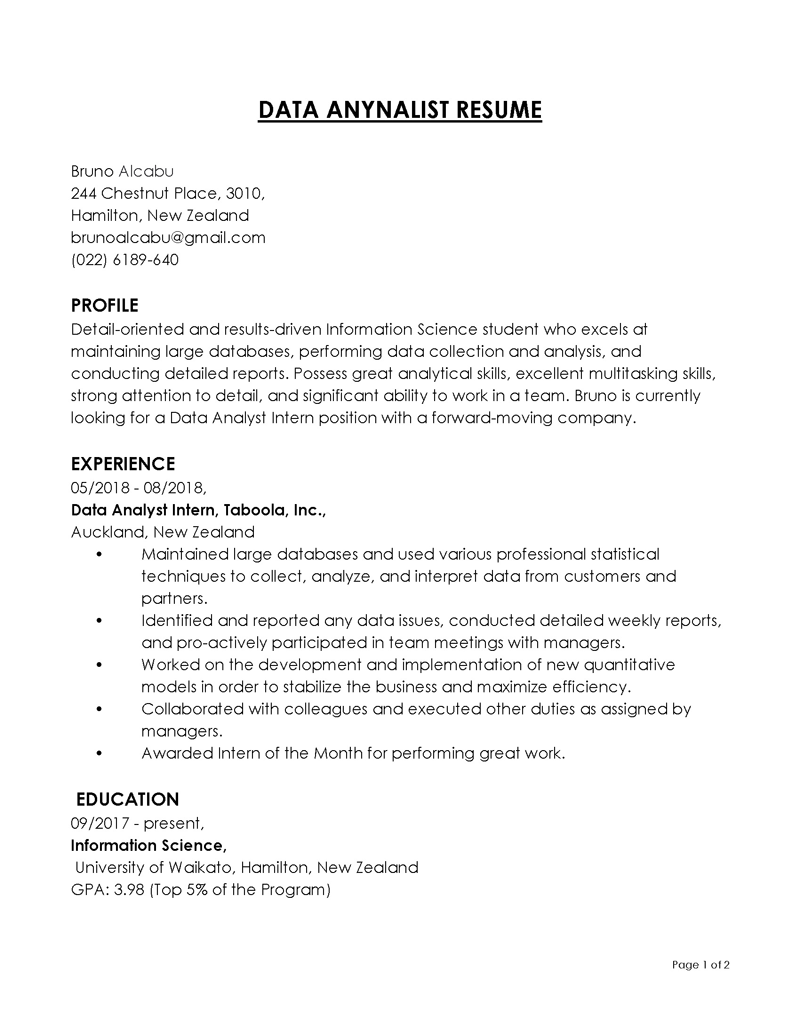
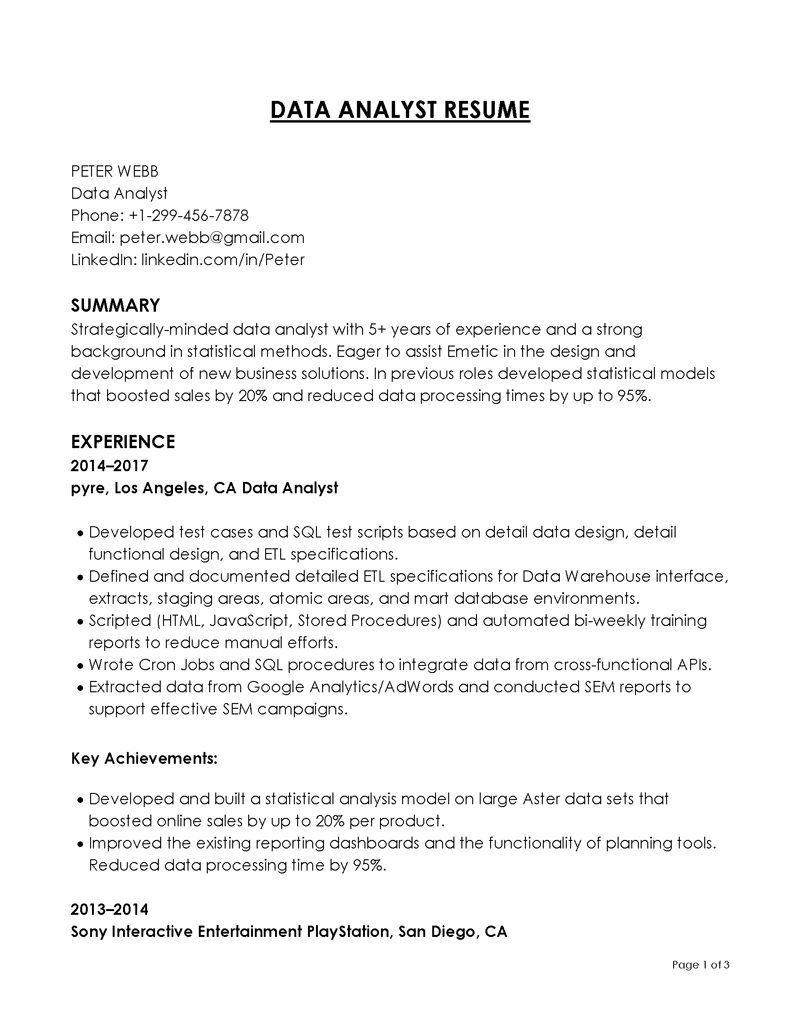
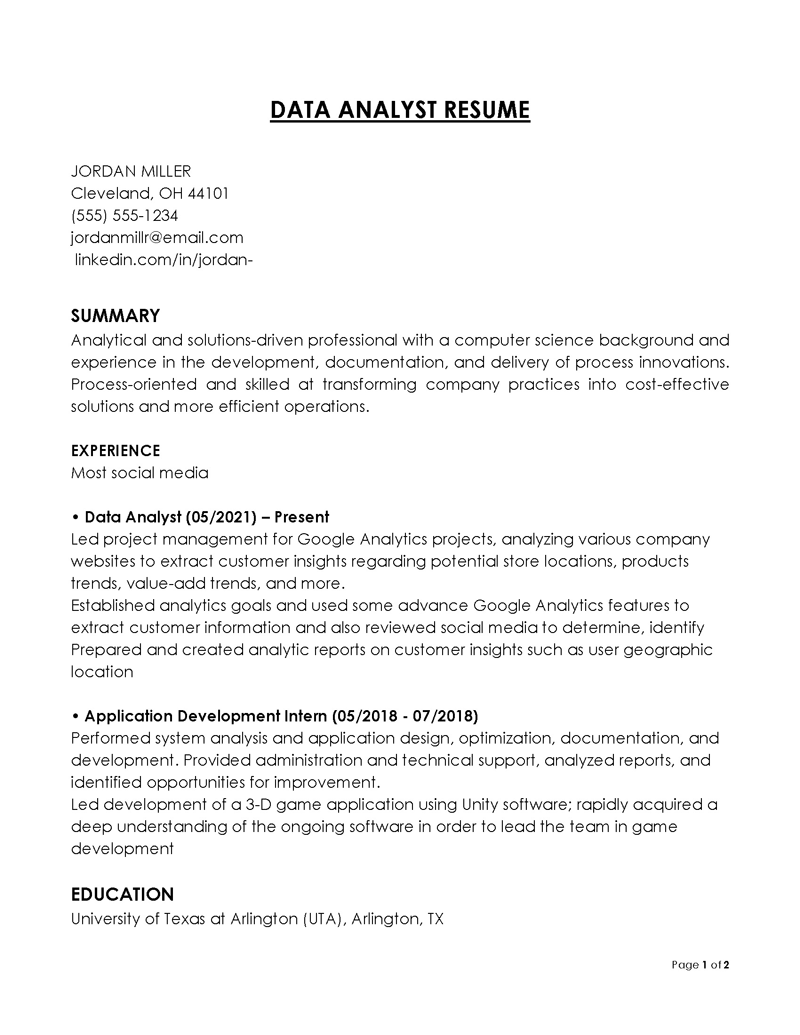
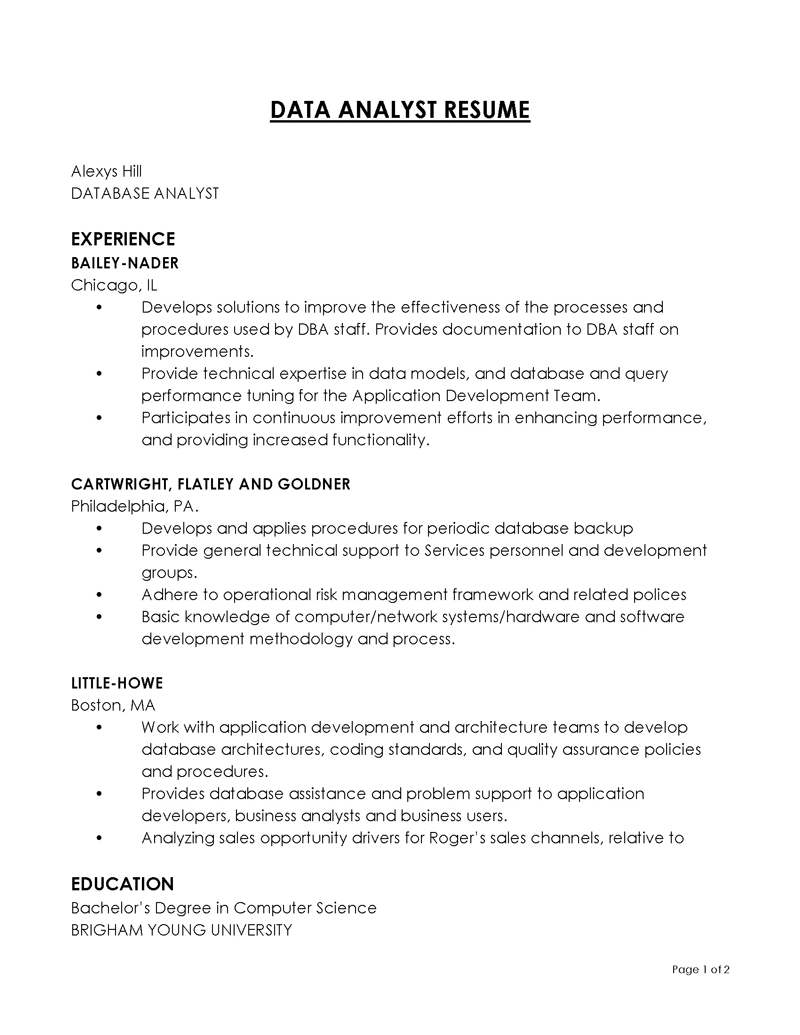
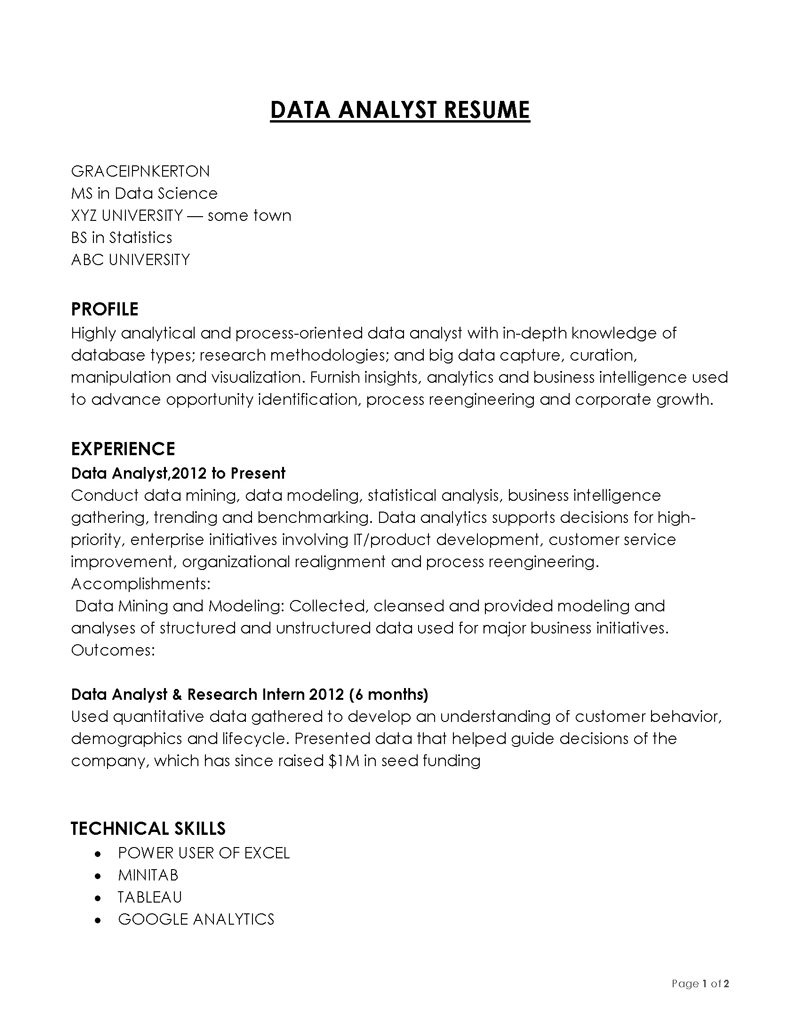
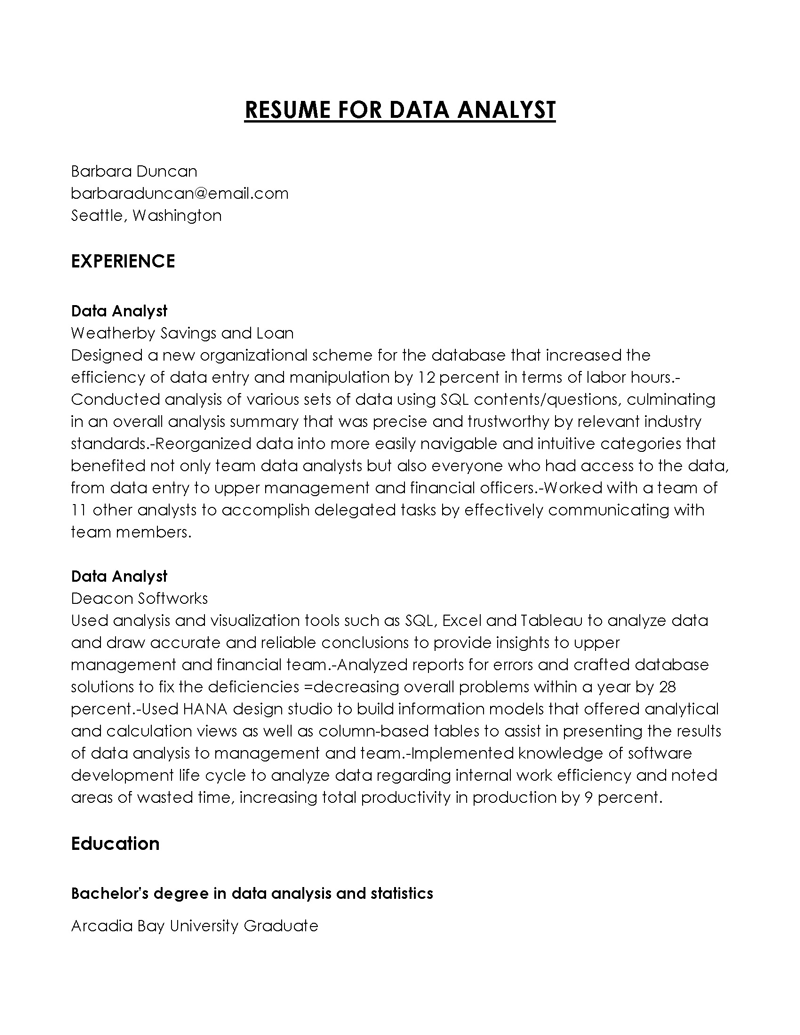
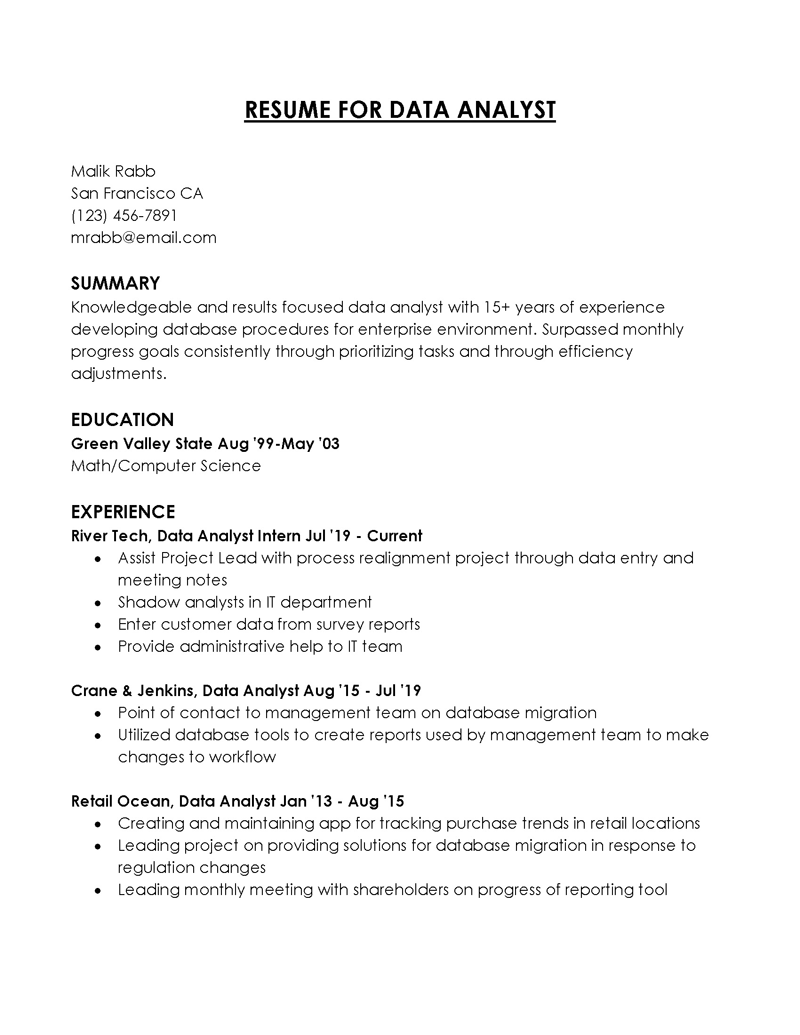
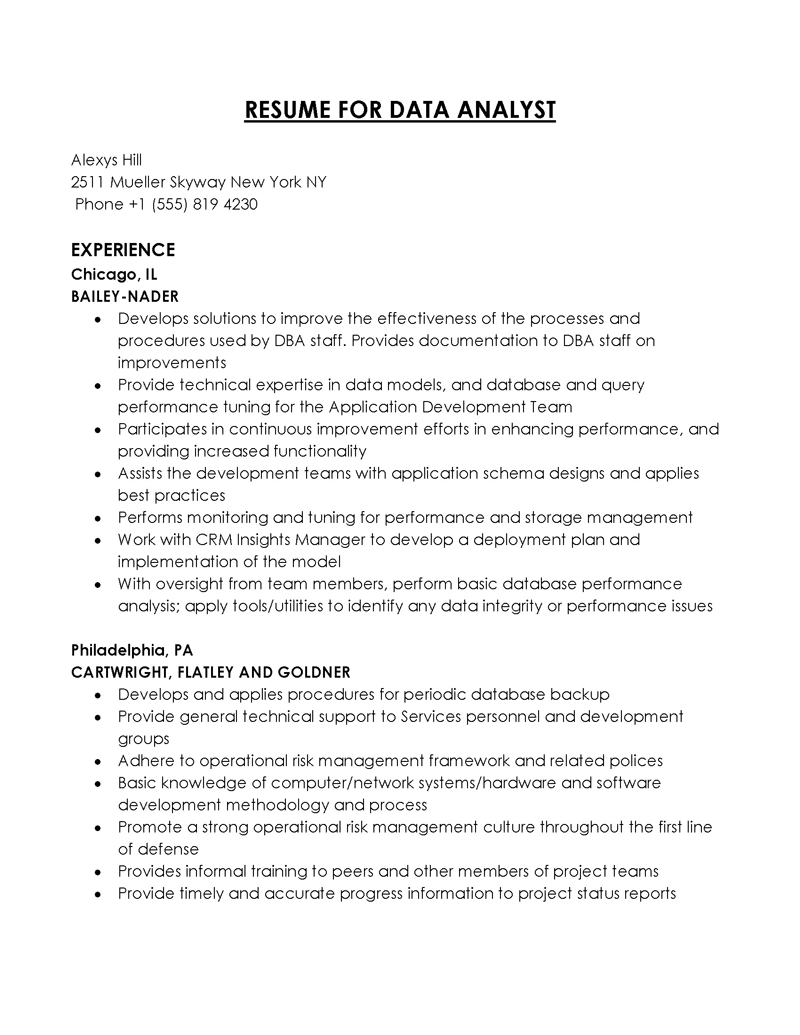
Responsibilities of Data Analyst
Data analysts are responsible for collecting, cleaning, and analyzing large data sets to identify trends, patterns, and insights. They use statistical methods, machine learning techniques, and data visualization tools to interpret complex data sets and translate them into actionable insights that drive business decisions.
Data analysts collaborate with cross-functional teams to understand their data needs and provide recommendations based on data analysis. They create reports, dashboards, and visualizations to present data clearly and concisely to stakeholders.
Additionally, they identify areas for process improvement and recommend solutions to optimize business operations. Overall, a data analyst plays a critical role in transforming data into valuable insights that drive informed decision-making across an organization.
How to Create Effective CV for Data Analyst
As a highly analytical and detail-oriented data analyst, your CV plays a crucial role in showcasing your skills and experience to potential employers. Your CV should highlight your expertise in analyzing complex data sets, identifying trends and patterns, and providing valuable insights to drive business decisions.
In this article, we will explore the key elements that make a successful data analyst’s CV, including the necessary skills, education, and professional experience. We will also discuss how to effectively communicate your achievements and present your qualifications to stand out from the competition.
Whether you are an experienced data analyst looking to update your CV or a newcomer to the field seeking guidance, this article will provide valuable insights to help you create a strong and effective CV.
Choose a Perfect Resume Layout
Being good is not always good enough; you must complement your skillset with a great resume. Regarding your data analyst resume, you want to ensure you pay attention to the details.
The following are the various types of resume layouts and their appropriate uses:
- Chronological CV: This is the most common format, where your work experience is listed in reverse chronological order, starting with your most recent position. This format is ideal if you have a consistent work history and want to showcase your career progression.
- Functional CV: This format focuses on your skills and experience rather than your work history. You can highlight your skills, achievements, and qualifications, and provide examples of how you’ve used them in previous roles.
- Combination CV: This format combines the chronological and functional formats, highlighting both your work history and skills. You can start with a summary of your skills and achievements, followed by a chronological listing of your work experience.
- Targeted CV: This format is tailored to a specific job or industry, highlighting your skills and experience relevant to the job you’re applying for. You can customize your CV to emphasize your expertise in specific areas of data analysis, such as data visualization or machine learning.
Provide a resume header
Your resume header should contain the following details:
- Your full name and any relevant certifications you hold, where applicable.
- Your level of experience (e.g., “entry-level” or “senior level”) and other relevant information about your title.
- Ensure you provide a business email and phone number for the recruiter to reach you if necessary.
- Include a link to your portfolio website, a LinkedIn profile, or a repository on your GitHub to show your work, collaborative, and networking skills.
A typical resume header for a data analyst can be illustrated below:
John Doe. (Senior Data Analyst)
Google Data Analysis Certified
mydataanalys@gmail.com.
+1 -234 -456-789.
LinkedIn.com/Johndoe.
Tip: Different sectors and nations have different rules about what can and cannot be included in a resume. Before applying for a job, it is a good idea to familiarize yourself with the local policies of the area. Email the company’s HR department if you have any issues about the kind of personal information required.
Include your personal statement
Summary and objective statements are similar in that they both sell you briefly and compellingly to the employer as they go through your resume. Both statements can be used, depending on the focus and specifics of the scenario.
1. Summary statement
This is a brief statement at the top of your resume that shows the potential employer your qualities and why you are best suited for the job.
Your summary statement can be written using this approach:
Experienced data analyst with 7 years of experience working with 12 companies to organize, analyze, and interpret data to make strategic business decisions. Skilled at utilizing qualitative and quantitative analysis principles to gather and improve analytics processes, improving work efficiency by 25%, and completing projects three months ahead of schedule.
2. Objective statement
An objective statement is a brief statement at the beginning of a CV that outlines the candidate’s career goals and what they hope to achieve by obtaining the job they are applying for
A typical example of one would be:
A recent graduate looking to secure a Data Analyst position with ABC Company, where professional technical and analytical skills will be an incredible asset to the company.
Tip: The main difference between the two types of statements is that a summary statement focuses on the candidate’s skills and accomplishments, while an objective statement focuses on the candidate’s career goals and aspirations. An objective statement is often used by entry-level candidates or those looking to switch career paths to signal to employers what kind of job they are looking for.
Provide a work section experience
When writing the work experience section of a resume, it is important to highlight your accomplishments and the impact you have had on the organizations you have worked for. Here are some tips on what to include:
- List your work history in reverse chronological order, starting with your most recent job and moving backward.
- For each job, include your job title, the name of the company, and the dates you worked there.
- Use bullet points to describe your responsibilities and accomplishments. Start each bullet point with an action verb to make your achievements more compelling.
- Quantify your accomplishments with numbers, percentages, or dollar amounts wherever possible. This will help demonstrate the impact you’ve had in your previous roles.
- Highlight any specific skills or tools you used in each role, such as SQL, Python, or Tableau.
- Tailor your descriptions to the job you are applying for, focusing on the skills and experience that are most relevant to the position.
Here is an example of a bullet point for the work experience section of a resume:
–Analyzed customer data using SQL and Excel to identify trends and patterns, resulting in a 15% increase in customer retention and a 10% increase in revenue.
Or
–Collaborated with cross-functional teams to identify business requirements and design data models for business intelligence and reporting purposes.
Or
–Created visualizations and reports using Tableau and Power BI to present insights to stakeholders, resulting in more informed decision-making.
Example:
Senior Data Analyst
ABC Company, France
2015-2019
–Used many software SQL and Cloudera to analyze the data and created the report within the given time limit.
–Using SQL, Python, and Excel improved customer satisfaction by 25%.
–Trained a team of 12 data analysts within a month.
–Led the company to the top of the most accurately analyzed data-providing companies.
Tip: If you belong to the category of applicants without any job experience, start by identifying all the relevant skills from the job description. Then, demonstrate to the employer that you possess those skills in other jobs, projects, or education, and present any relevant contributions or certificates you have acquired in the field.
Include an education section
Most data analyst roles will require a bachelor’s degree in data science, business analytics, computer science, or other statistics-related fields. Even though these credentials are advantageous, you can still get a job as a data analyst without them.
You can include any statistics course or an online certification course in data science in your resume’s education section.
Your education section should look like this:
Education:
MSc. Computer Science and Statistics, 2017-2018
Massachusetts Institute of Technology, Massachusetts, USA
Tip: Not having a relevant degree does not reduce your likelihood of being hired for a data analyst position. You can include your relevant certifications instead. It could also be an excellent opportunity to win your employers’ attention by explaining why your career switched to data science when you are interviewed.
List your certifications correctly
The certification section of a data analyst’s CV should showcase your relevant certifications and training programs that demonstrate your expertise in data analysis. Here are some tips on how to write this section:
- Start by listing your certifications in reverse chronological order, with the most recent certification first.
- Include the name of the certification, the issuing organization, and the date you received it.
- If the certification has an expiration date, include that as well.
- If you have multiple certifications, organize them into relevant categories, such as Data Analysis Tools, Statistical Analysis, or Machine Learning.
Your certifications section should be organized like this:
–Tableau Desktop Certified Associate, Tableau Software, 2022
–Microsoft Certified: Azure Data Scientist Associate, Microsoft, 2021 (expires 2024)
–Google Analytics Individual Qualification (IQ), Google, 2020 (expires 2023)
–SAS Certified Statistical Business Analyst Using SAS 9: Regression and Modeling, SAS, 2019
Include your technical and soft skills
This section provides the reader with an overview of your strengths. As a data analyst, you must have a solid understanding of descriptive and inferential statistics that allows you to understand the behavioral patterns of customers, valuable classifications, and other critical business information.
Here is an example of the technical skills section of a data analyst’s resume:
–Excellent knowledge of Python, Data Visualization, SQL, and Data Cleaning.
–Expert user of Microsoft Excel, Minitab programs, and SAS Enterprise Miner.
Unless you have certification for these technical skills, which you should include in the certifications section, it is okay to list your technical skills in this manner.
There are a wide variety of soft skills that data scientists can demonstrate to boost their chances of employment and ultimately make them valuable assets to the company.
Your soft skills section should look like this:
–Critical thinker, and a strong team player, with creative problem-solving skills.
–Practical communication skills and efficiency in meeting up with deadlines.
–Technologically savvy to help relate data to end users in a more user-friendly approach.
Include any relevant sections (if needed)
Including additional sections in a data analyst’s CV can help highlight the individual’s specific skills, experiences, and achievements beyond their work experience and education. These additional sections can provide a more comprehensive picture of the candidate’s capabilities and interests and can help them stand out from other applicants.
Some additional sections that can be included:
- The Projects section can showcase any data analysis or machine learning projects that the candidate has worked on. This can include the problem statement, the methodology used, the data sources, the tools and techniques employed, the results achieved, and any visualizations or reports generated.
- The Publications section can list any research papers, case studies, or articles that the candidate has authored or co-authored in the field of data analysis. This can demonstrate thought leadership and expertise in the field.
- The Awards and Honors section can list any awards, scholarships, or honors that analyst has received for their work in data analysis. This can include academic awards, professional awards, or recognition from industry associations or publications.
- The Professional Memberships section can list any professional organizations or associations that the candidate is a member of. This can show a dedication to continuing education and keeping current with the best methods and trends in the data analysis industry.
- The Volunteer Work section can showcase any volunteer work or community service that the candidate has participated in, particularly if it is related to data analysis or technology. This can demonstrate a passion for the field and a desire to use one’s skills to make a positive impact.
Tips to Consider
Your ability to organize all of your information into a professional-looking resume differentiates you from the competition. Below are some essential factors to consider when creating your resume:
Proper formatting
Follow these tips for creating a professionally formatted resume:
- Use a clear and easy-to-read font, such as Arial, Calibri, or Times New Roman.
- Keep the font size between 10-12 points to ensure that the text is readable.
- Use bullet points to organize information and make it easier to read.
- Use bold and italic formatting to highlight important information, such as section headings or key accomplishments.
- Use a clean and simple layout with plenty of white space to make the resume easy to scan.
- Use consistent formatting throughout the resume, such as the same font, size, and style for headings and bullet points.
- Use a professional tone and avoid using slang or informal language.
- Ensure that the margins are consistent and that the entire resume fits on one or two pages.
Proofread and polish the resume
Make sure to proofread and edit your resume carefully, checking for spelling and grammatical errors, formatting inconsistencies, and overall clarity. Have someone else review it as well to get a fresh perspective.
Tailor your resume for each job
Modify your resume to fit the job description you seek. For example, as a data analyst well versed in Microsoft Excel and Python, if you apply for a job where Python is the primarily accepted programming language, you should consider adjusting your resume to highlight your Python skills.
In addition, if you have completed projects or have experience directly applicable to the position you seek, include them, as they improve your chances of getting shortlisted for an interview.
Use action verbs
Action verbs are strong, active words that help to convey your achievements and responsibilities more strongly. Using action verbs can help make your resume more impactful and demonstrate your skills and achievements more effectively.
When using action verbs, make sure to use them in the past tense (e.g., “analyzed data to identify trends”) to highlight your past experiences and accomplishments. Incorporating action verbs in your resume can make it more dynamic and engaging.
Some examples of action verbs that can be used in a data analyst’s resume are:
- Analyzed
- Visualized
- Interpreted
- Developed
- Collaborated
- Optimized
- Implemented
- Evaluated
- Generated
- Identified
Make the CV ATS compliant
The Applicant Tracking System, or ATS, is software used to filter applicants’ resumes. This software checks for specific keywords in the application; if an applicant’s resume does not contain the right keywords, the applicant may be disqualified automatically by ATS, even if they are otherwise qualified for the position. So, ensure your resume has all the keywords mentioned in the job description.
Key Takeaways
- It is essential to show that you can take analytical findings and turn them into something that will yield profit for your employers.
- As a data analyst, your technical skills are essential. Highlight your expertise in programming languages, data visualization tools, and statistical analysis software.
- Share the full scope of your most significant projects.
- Use specific examples of projects or analyses you have completed in previous roles to demonstrate your skills and experience.
- All your technical skills and experiences should be listed in your work history section.
- Provide a detailed account of prior experience and education when applying for a job. Highlight any relevant education or certifications, such as a degree in statistics or a certification in a programming language.




